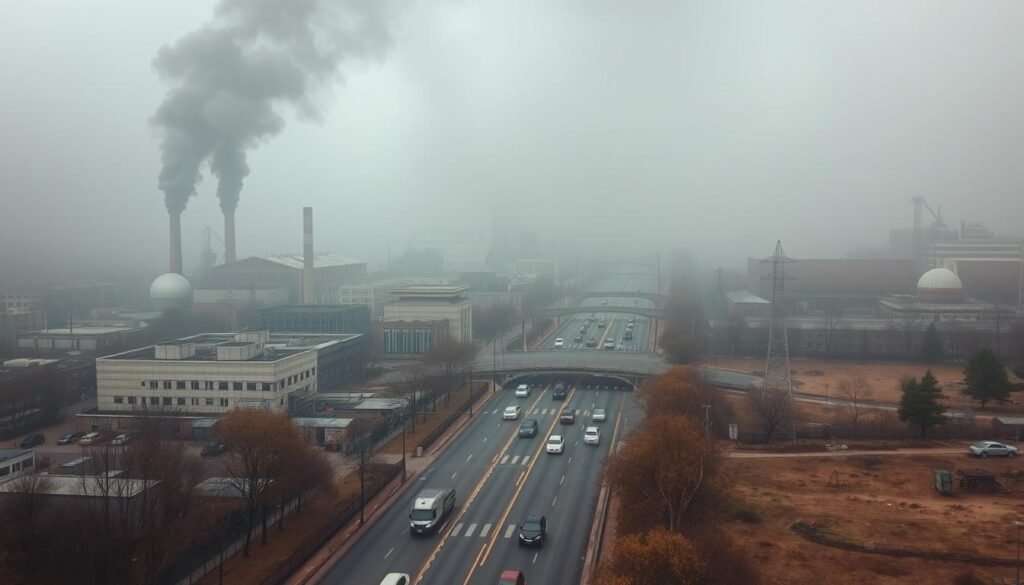In the United States, about 80% to 90% of lung cancer deaths are due to cigarette smoking. This fact shows how crucial it is to know the risk factors for lung cancer. It also highlights the importance of catching it early and preventing it. Lung cancer is the top killer among cancers worldwide. So, knowing what increases your risk, like smoking and being around certain environmental elements, is key.
Risk factors are things that make it more likely someone will get a disease. For lung cancer, these can be lifestyle choices, your environment, or even your genes. We’ll look into factors like smoking, being around smoke from others, jobs that could be harmful, and what we eat. By understanding these factors and spotting the early warning signs, people can do a lot to prevent or catch lung cancer early.
Key Takeaways
- Cigarette smoking is responsible for 80% to 90% of lung cancer deaths.
- People who smoke are 15 to 30 times more likely to develop lung cancer than non-smokers.
- Secondhand smoke is the third leading cause of lung cancer in the U.S.
- Indoor radon is a significant risk factor for lung cancer, particularly among non-smokers.
- Occupational exposures to carcinogens like asbestos can greatly increase lung cancer risk.
Understanding Lung Cancer
Lung cancer is a major health issue caused by the growth of abnormal cells in the lungs. It is mainly classified into two types: small cell lung cancer and non-small cell lung cancer. Detecting it early is hard because its symptoms often don’t appear until it is advanced.
- Persistent cough
- Chest pain
- Difficulty breathing
- Coughing up blood
- Weight loss and fatigue
Knowing what lung cancer means is very important. This information helps people get the right help early, which can improve the chances of treating lung cancer successfully. Being aware of and spotting the symptoms early can really help in managing lung cancer effectively.
What Are Some Risk Factors for Lung Cancer
Knowing risk factors for lung cancer is key. Smoking, secondhand smoke, and chronic lung diseases increase risk. Knowing these facts helps people make healthy choices.
Smoking as the Leading Cause
Smoking is the top risk factor for lung cancer. It’s linked to about 90 percent of cases. The more and longer people smoke, the higher their risk. Heavy smokers are especially at risk.
Continuous smoking also leads to other health problems besides lung cancer.
Impact of Secondhand Smoke Exposure
Secondhand smoke is a big problem, especially for those who don’t smoke. It causes around 7,300 lung cancer cases each year in the U.S. Being near smokers often increases the risk for non-smokers. Creating smoke-free areas is crucial for health.
Role of Chronic Lung Disease
Chronic lung conditions like COPD also raise lung cancer risk. These diseases cause ongoing lung inflammation and damage. This makes people more likely to get lung cancer. Knowing how chronic lung disease and cancer risk connect is important for care.
How Smoking Affects Lung Cancer Risk
Smoking is a leading cause of lung cancer. It greatly raises the risk of this fatal disease. By looking at the numbers, we see how big of a problem it is. Studies make it clear that how much you smoke can change your risk level. It’s vital to know about these dangers.
Statistics on Smoking and Lung Cancer
Every year, lung cancer kills over one million people worldwide. For lung cancer cases, smoking is blamed for about 90% in men and 70% to 80% in women. Smokers are 15 to 30 times more likely to get lung cancer than nonsmokers. In the U.S., lung cancer is behind 31% of all cancer deaths in men and 26% in women. It is a huge health crisis.
Effects of Cigar and Pipe Smoking
Some think cigar and pipe smoking are less harmful. But, they are just as dangerous as cigarettes. The risk of getting cancer from these is similar to smoking cigarettes. Tobacco products, no matter the type, can lead to lung cancer. They harm lung health and increase cancer risk.
Impact of Low-Tar and Menthol Cigarettes
Choosing low-tar or menthol cigarettes might seem safer, but it’s not. Research shows they’re just as bad as regular cigarettes in terms of cancer risk. Quitting smoking can greatly cut down your cancer risk. This is true no matter how long you’ve smoked before.
| Smoking Type | Cancer Risk | Comparison to Non-Smokers |
|---|---|---|
| Cigarette Smoking | 90% of lung cancer cases in men, 70-80% in women | 15-30 times increased risk |
| Cigar Smoking | Similar risk of lung cancer | Comparable to cigarette smoking |
| Pipe Smoking | Significant cancer risk | Similar to cigarette smoking |
| Low-Tar Cigarettes | No significant reduction in cancer risk | As harmful as traditional cigarettes |
| Menthol Cigarettes | Similarly harmful cancer risk | As harmful as traditional cigarettes |
Environmental Risks Associated with Lung Cancer
Many things in our environment can lead to lung cancer. Radon gas and air pollution are two big dangers. Knowing about these risks helps us protect our lungs.
Radon Gas: The Silent Killer
Radon gas comes from the natural breakdown of uranium in the ground. It’s colorless and has no smell. It can build up in homes, especially basements. This gas is risky for lung cancer, more so for people who don’t smoke.
It’s important to check radon levels in your home. High levels can be a serious danger. Studies show that non-smokers can die from lung cancer because of radon in their homes.
Air Pollution and its Effects
Air pollution is mostly in cities. It comes from cars and factories. This pollution increases the chance of getting lung cancer.
Even though it’s not as dangerous as smoking, air pollution still harms our lungs. It is a big environmental problem that affects our health.

Occupational Exposures Related to Lung Cancer
Some jobs can raise the risk of lung cancer a lot. Workers around cancer-causing substances face big health risks. Knowing about these dangers is key to avoiding and managing them.
Carcinogens in the Workplace
Many harmful substances are found at work. People may touch things like asbestos, arsenic, diesel exhaust, and silica. The International Agency for Research on Cancer (IARC) has a list of these dangerous substances. This list shows why it’s important to keep work places safe.
Specific Jobs with High Risk
Some jobs have a higher danger because of these bad substances. Mining, shipbuilding, and construction jobs are especially risky. Here’s a table that shows some of these jobs and what dangerous stuff they might come into contact with.
| Occupation | Common Carcinogen Exposure |
|---|---|
| Shipbuilding | Asbestos |
| Mining | Silica, Asbestos |
| Construction | Diesel Exhaust, Silica |
| Manufacturing | Arsenic, Nickel |
Asbestos and Its Long-term Effects
Being around asbestos is still a big worry in some jobs. The worst parts of asbestos exposure may show up years later. These include really bad lung problems and cancer. It’s super important to protect workers and keep them healthy.
Genetic and Family History Factors
Understanding genetic and family history is key in seeing lung cancer risk. Your genes play a big role in this disease’s risk. If you or your family had lung cancer, your risk goes up.
This is especially true for close family like parents or siblings. This might be due to shared genes and environments. Factors like smoking or radon gas can also play a part.
Personal History of Lung Cancer
Having had lung cancer before increases your risk of getting it again. This past diagnosis can affect your health in the future. Research shows that you might get other cancers more often too.
This means watching your health and getting check-ups is crucial. Knowing your personal history can guide prevention efforts for you.
Implications of Family History
Your family’s history with lung cancer greatly affects your risk. Studies show that if your family members had it, your risk is higher. For example, the risk is higher if your dad (1.41), mom (2.14), or siblings (1.53) had lung cancer.
This info urges people with lung cancer in their families to be careful with their health. Knowing about your family’s and your own medical history helps you understand your risk better.
The Role of Previous Radiation Therapy
Previous radiation therapy, especially in the chest area, raises the risk of lung cancer. It can harm lung tissue, leading to mutations that increase cancer risk. Patients with thoracic intensity-modulated radiation therapy may see more radiation pneumonitis. This is a lung injury from radiation.
Around 51.0% of lung cancer patients with a specific lung condition get severe radiation pneumonitis within a year. About 20.9% face even worse effects during the same time. High radiation doses to the lungs are linked to this condition, especially after previous lung cancer treatments.
Increased risk of radiation pneumonitis also comes from chemotherapy with gemcitabine and high lung radiation exposure. It’s key to measure lung radiation closely to see how it relates to lung cancer risks. Checking how much lung gets over 20 Gy of radiation helps us understand radiation-induced lung toxicity.
For women getting radiation for breast cancer, the stakes are higher. They have a greater risk of lung cancer, making their care more complex.
Knowing the effects of past radiation therapy is essential for both patients and doctors. Ongoing research and educating patients can reduce the dangers of higher cancer risk from earlier treatments.
Dietary Factors and Lung Cancer
What you eat plays a big role in lung cancer risk. Certain diets can make you more or less likely to get this disease. Eating lots of fruits and vegetables can help protect you against lung cancer.
On the other hand, eating a lot of red meat might increase your risk.
Vitamins and Supplements: A Double-Edged Sword
Vitamins are important, but supplements can be risky for some, like smokers. High doses of beta-carotene supplements can raise the risk of lung cancer in smokers. Eating a balanced diet full of whole foods is a safer way to get your vitamins.
Fruits and vegetables can lower the chance of lung cancer by 32%. The “Tex-Mex” diet, with lots of fruits and vegetables, cuts the risk by an amazing 55%.
The Impact of Arsenic in Drinking Water
Arsenic in drinking water, often from private wells, increases lung cancer risk. This harmful element can cause damage over time. It’s vital to have clean water to lower cancer risk.
Arsenic shows how important the environment is to our diet and health. Knowing how to drink safely can help prevent lung cancer.

| Dietary Pattern | Association with Lung Cancer Risk |
|---|---|
| Fruits and Vegetables | 32% reduced risk (OR=0.68; 95% CI=0.55-0.85) |
| Tex-Mex | 55% reduced risk (OR=0.45; 95% CI=0.37-0.56) |
| American/Western | 45% increased risk (OR=1.45; 95% CI=1.18-1.78) |
For more on how your diet impacts lung cancer risk, including the effects of vitamins and the environment, check out current research.
Warning Signs of Lung Cancer
Lung cancer can be tricky because it might not show symptoms early on. Knowing the warning signs is crucial for early help. Spotting lung cancer early can make treatment work better. It’s important not to ignore common symptoms. They might mean you need to see a doctor right away.
Common Symptoms and Their Importance
Finding the early signs of lung cancer can save lives. Often, symptoms don’t get noticed until the cancer grows. The main warning signs include:
- Persistent cough
- Coughing up blood
- Chest pain
- Hoarseness
- Loss of appetite
- Weight loss
- Shortness of breath
- Fatigue
- Recurring infections
Also, some symptoms show up when the cancer has spread. This includes bone pain and changes in the nervous system. Knowing these can push us to get checked early.
When to See a Doctor
If you have any of these symptoms, seeing a doctor should be a priority. Catching it early improves treatment success drastically. If symptoms point to advanced issues like Pancoast tumors, you need urgent care.
Lung cancer is a big risk to our health. Being quick to act on its warning signs can lead to better health outcomes. Early detection and treatment are key.
Prevention Strategies for Lung Cancer
Making wise choices can greatly cut the risk of lung cancer. Choosing a healthy lifestyle and environment is key. This includes stopping smoking, steering clear of secondhand smoke, and checking your home for radon.
Quitting Smoking and Its Benefits
Stopping smoking is a powerful step. It sharply decreases lung cancer risk for people of all ages and smoking histories. The benefits of quitting start right away, boosting overall health. It also lowers the chances of getting lung cancer.
Avoiding Secondhand Smoke
It’s vital to keep environments free from smoke. This protects non-smokers from the dangers of secondhand smoke. By making homes and workplaces smoke-free, you protect the health of those around you. This greatly reduces their risk of being exposed to substances that can cause cancer.
Testing for Radon in Homes
Radon is a leading cause of lung cancer among non-smokers. It’s important to test your home for radon levels. By taking steps to lessen radon, you can safeguard your family’s health. For detailed advice on prevention, check the American Cancer Society.

Staying Informed About Lung Cancer Risks
Knowing lung cancer risk factors is key to early detection and prevention. By learning about lifestyle, environment, and genes, people can make better choices for lung health.
The Importance of Awareness and Education
Being aware of lung cancer risks can help communities. They learn the dangers of smoking, secondhand smoke, and harmful exposures. Programs can teach important safety steps and healthy habits.
Here are important risk factors to know:
- Smoking causes 80% of lung cancer cases.
- Being around smoke can also raise your risk.
- Radon gas is natural but should be checked in homes.
- Having lung diseases can make cancer more likely.
- Some jobs expose people to dangerous substances.
- Arsenic in water can increase cancer risk.
Education and health efforts can lower these risks. When people learn about lung cancer, they can fight it better.
Conclusion
Knowing the risks for lung cancer helps us fight it better. Smoking is the biggest cause, leading to about 85% of cases. Things like air pollution and radon gas also play a big role. It’s key to see that lung cancer rates are high for both men and women all over.
Genetics can also make someone more likely to get lung cancer. If you know your family has a history, you can act early. Getting regular check-ups and eating lots of fruits and veggies can help catch it early and treat it.
To cut down on lung cancer risk, we need to focus on keeping our lungs healthy. By knowing and managing risks, we can help lower the rates of lung cancer. This makes our communities healthier and helps everyone live better lives.